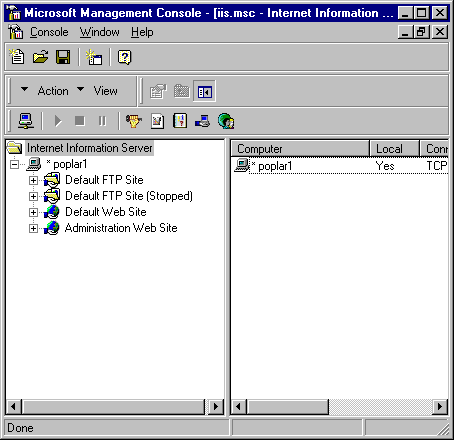
Choose your web server:
The SEAGULL Web Manager is easy to install and requires very little time or resources.
Insert the CD-ROM into your CD drive. An "auto-run" program will launch and you will be presented with the Welcome to BlueZone "Splash" screen.
Click on the SEAGULL Products link.
Select the SEAGULL ASP Web Manager link. This will start the installation process.
The Web Manager Setup dialog box will appear. Leave the default vales as they are and click the Install button to start the installation.
Respond as need to the licensing and directory creation questions. The Web Manager files will now be copied to your server.
After the Web Manager installation program is complete, you should receive the following message: “The SEAGULL Web Manager installation completed successfully”.
Click the OK button to continue.
On Windows NT 4.0 Servers, the Web Manager files are by default copied to the following directory:
C:\Inetpub\wwwroot\SWM\
In order for the Web Manager to work properly, it is necessary to name the application path. This is done through the Microsoft Internet Service Manager.
Launch the Microsoft IIS Internet Service Manager Console:
Go to:
Start:Programs:Windows NT 4.0 Option Pack:Microsoft Internet Information
Server:Internet Service Manager.
In the top of the left hand pane find your server name. My server happens to be called “poplar1”. You server name will be different.
Expand the tree next to your server name so you can see your web sites.
Find your web site. There could be more than one. When IIS is first installed, the name automatically assigned is “Default Web Site”. Your Management Console should look something like this:

Expand your web site tree, highlight the SWM directory, right click and select properties. You will see the following screen:
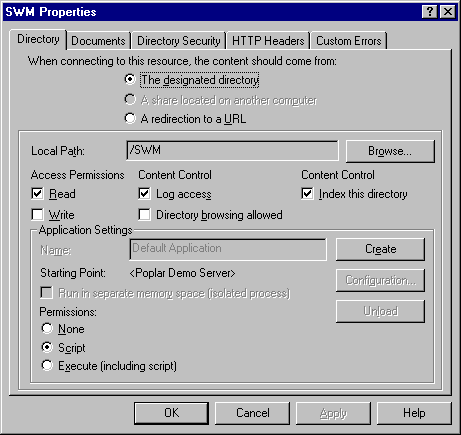
Click the Create button and you will see a box where can enter the name of the application, as shown:
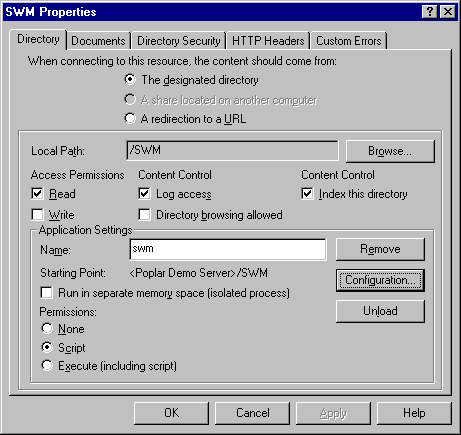
Enter the name the application, swm (as shown above) and click the Apply button.
Click the Document tab. You should see the following dialog:
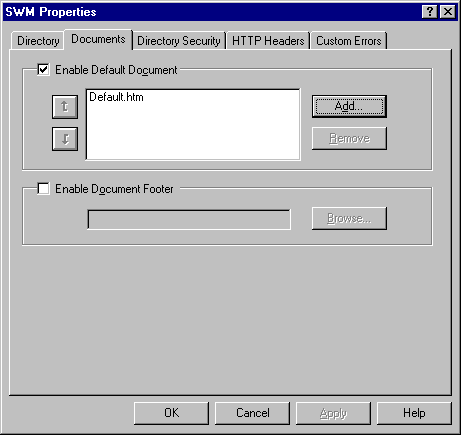
 NOTE Since
BlueZone Web-to-Host is an ASP application, you must tell IIS that the
default page is default.asp and not default.htm.
NOTE Since
BlueZone Web-to-Host is an ASP application, you must tell IIS that the
default page is default.asp and not default.htm.
Click the Add button. You will be presented with the Add Default Document dialog.
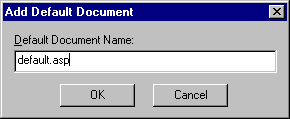
Type in deafult.asp and click the OK button.
Move the default.asp entry to the top of the list by clicking on the up arrow button.
Click OK to save exit this dialog.
Using the IIS Management Console, go to the SWM folder and expand it by clicking on the plus sign.
Find the folder called "access" and select it. This is where Web Manager stores its database.
Right click and select Properties. The Properties dialog for this folder will display.
De-select the Read checkbox and set the Permissions radio button to None.
Click OK to close the dialog.
The SWM application will have permission to access the data via ODBC, but web browsers will not be able to download the database file to their machines.
Congratulations! The basic installation portion of the Web Manager is complete.
Proceed to the next section: Installing the SEAGULL Activation File
The SEAGULL Web Manager is easy to install and requires very little time or resources.
Insert the CD-ROM into your CD drive. An Auto-Run program will launch and you will be presented with a SEAGULL BlueZone Software contents page.
Click on the SEAGULL Products link.
Select the SEAGULL ASP Web Manager link. This will start the installation process.
The Web Manager Setup dialog box will appear. Leave the default vales as they are and click the Install button to start the installation.
Respond as need to the licensing and directory creation questions. The Web Manager files will now be copied to your server.
After the Web Manager installation program is complete, you should receive the following message: “The Seagull Web Manager installation completed successfully”.
Click the OK button to continue.
On Windows 2000 Servers, the Web Manager files are by default copied to the following directory:
C:\Inetpub\SWM\
In order for the Web Manager to work properly, it is necessary to create a Virtual Directory. This is done through the Microsoft Internet Services Manager.
Launch Microsoft IIS Internet Services Manager:
Go to: Start:Programs:Administrative Tools:Internet Services Manager.
In the top of the left hand pane find your server name. My server happens to be called “elm”. You server name will be different.
Expand the tree next to your server name so you can see your web sites.
Find your web site. There could be more than one. When IIS is first installed, the name automatically assigned is “Default Web Site”. Your Management Console should look something like this:
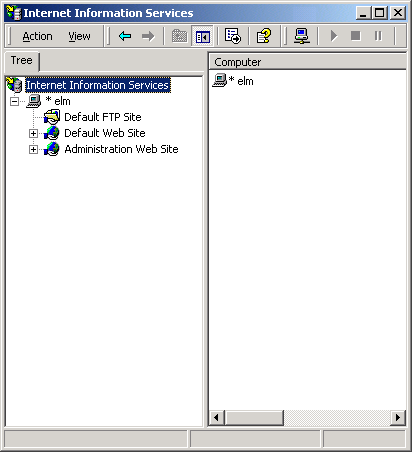
Highlight your web site and right click.
Go to New:Virtual Directory and left click.
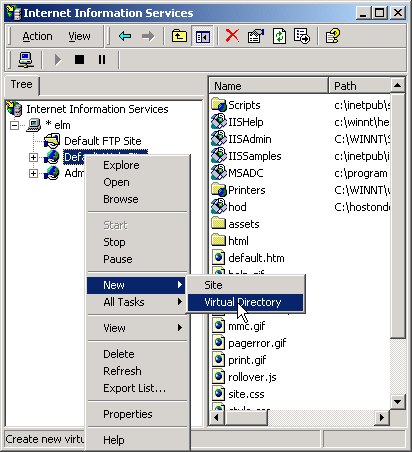
A New Virtual Directory Wizard will appear. Click Next to continue.
Enter an “alias” name to be used to access this directory. The name can be the same as the directory that was just created like swm. Click Next.
Enter the path to the directory. I suggest that you browse to it using the Browse button. Once you have the path, click Next.
Don’t change any settings, click Finish.
Using the IIS Management Console, go to the SWM folder and expand it by clicking on the plus sign.
Find the folder called "access" and select it. This is where Web Manager stores its database.
Right click and select Properties. The Properties dialog for this folder will display.
De-select the Read checkbox and set the Permissions drop down box None.
Click OK to close the dialog.
The SWM application will have permission to access the data via ODBC, but web browsers will not be able to download the database file to their machines.
Congratulations! The basic installation portion of the Web Manager is complete.
Proceed to the next section: Installing the SEAGULL Activation File